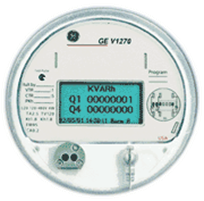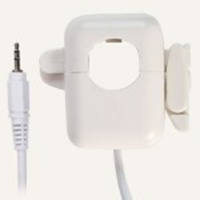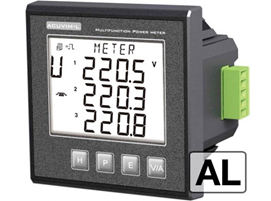
Projects are required to provide an electric meter that permits the building owner or manager to read the instantaneous power in kilowatts being used by the building, and to be able to reset and measure energy use in kilowatt-hours over a period of his own choosing. If this is possible from the utility company’s revenue service meter, then an additional meter does not need to be provided.
For larger buildings and electrical systems (greater than 250 kVA, which is 700 amps at 120/208 volts three phase and over 1000 amps at 120/240 volts single phase), the meter must also record the historical peak demand in kilowatts.
For much larger systems (greater than 1000 kVA, which is over 2700 amps at 120/208 volts three phase and over 4000 amps at 120/240 volts single phase, the meter must also be able to report the kWh for a fixed rate period.
Table 130.5-A (see page 13 below) repeats these requirements in table form.
The word service originates in Article 110 of Title 24 Part 3, the California Electrical Code. The Code intends that the service is where electric power enters a building or other structure. For safety and security, there are number of specific requirements for the service, such as where they must be located, how many disconnecting devices may be used, and how they must be labeled, as described in Article 230 of the Code.
The Electrical Code defines service as, “The conductors and equipment for delivering electric energy from the serving utility to the wiring system of the premises served”. To many people, this indicates that the service is where a utility company provides power to the building or structure. In fact, most buildings are served directly by the electric utility company, and the service includes a revenue meter. The requirements of Section 130.5(A) refer to this service and to this meter.
But not all buildings are connected directly to the utility company and not all services have revenue-measuring meters. For example, a college campus might purchase bulk power from an electric utility company, to save energy costs. The revenue meter is located where the electric utility company connects to the customer’s power distribution system. From this point on to the campus’ buildings, the customer owns the electrical system and becomes the serving utility for the purposes of the Code.
It is the intent of Section 130.5(A) that the service to every building or structure be metered so that its energy use can be monitored. For most buildings, the utility revenue meter can meet this requirement if it includes the read-out provisions indicated in Table 130.5-A. However, if a customer’s power distribution system serves a number of buildings, then a customer-owned meter meeting the requirements of Table 130.5-A must be provided for each building. Note that this meter does not need to “revenue grade”, which typically means 0.2% accuracy; less accurate metering is acceptable, as the point of this metering is to help the owner determine building energy use for management and planning purposes.
Sometimes buildings are not connected to a utility company at all. Power may be obtained from a generating system such as a diesel generator, wind turbine, or photovoltaic system without a grid tie. In each case, the generating system becomes the serving utility. As above, metering is not required to be revenue grade, but it is required to permit energy use management.
In rare cases, a building may have more than one service. These may include:
•Fire pump service(s)
•Emergency generating system(s)
•Legally required standby generating system(s)
•Optional standby generating system(s)
•Parallel power production systems
•Systems designed for connection to multiple sources of supply for the purpose of enhanced reliability
•Multiple-occupancy buildings where there is no available space for service equipment accessible to all occupants
•A single building or other structure sufficiently large to make two or more services necessary, including buildings where the capacity requirements are in excess of 2000 amperes at a supply voltage of 600 volts or less, or where the load requirements of a single-phase installation are greater than the serving agency normally supplies through one service
As the intent of Section 130.5 is to allow general energy use measurement for management purposes, metering is only required for those services that regularly provide electric power to the building or structure. In general, this includes e) through h). For instance, a photovoltaic system regularly provides power and is (e) a parallel power system.
Some projects with emergency power or standby power sources use them for peak-load shaving. If the building is designed to do this, metering on these services is also recommended, as they also constitute a parallel power system. However, if the alternative power source is only used for emergency conditions, metering is not required (although it is strongly recommended).
Metering of electrical power involves three key components:
•Current transformers (CTs), usually 2 or 3, which are typically in the shape of a doughnut and the power wire being measured goes through the doughnut hole’; and,
•Voltage measurement, phase to phase and/or phase to neutral, with isolation transformers in some instances; and,
•A meter to which the voltage wires and output of the CTs are connected
The simple residential meter has everything in a single box. Most people are familiar with the electromechanical residential and small commercial meter shown in Figure 8-1.

The electromechanical meter shown above is obsolete. Most new meters are electronic, and over time, most old meters will be replaced with an electronic meter. Meters with electronic data collection, analysis and communications ability are commonly called “smart meters”. Modern “smart” utility meters generally have all of the required features of this mandatory requirement, and more. The question is whether the building owner can access the information. The utility company owns the meter and there is no clear requirement for them to offer access to the data. If data access is provided, the mandatory requirement is met with the utility meter.

It may be desirable add a separate meter so that the building owner can have access to all of the data he needs. Adding a meter includes adding CTs, which will require room in a cabinet separate from the utility company CTs.


A split core CT can be installed on an existing wire without de-energizing. This is a residential and light commercial grade CT with plug connection to a digital energy meter
The accuracy of metering is an issue. In general, “revenue grade” metering requires high accuracy CT’s and metering equipment. Energy-management metering CT’s can be less accurate without affecting their role and purpose.

The meter itself can be located remotely from the CT’s, making it easier to read. Most electronic meters have a digital output that permits remote reading using specific hardware and software. Many can be read using a web browser and a password if the meter is connected to the Internet or building Ethernet.
•A meter that can be read by the building owner or occupant must be provided. This applies to any electrical service and is invoked any time that any section of the Standard applies and a permit is obtained.
•It must allow the building owner or occupant to view instantaneous power (kW) and have a manually resettable cumulative energy measurement (kWh) permitting periodic review of total electric energy use.
•Larger services will require additional capabilities identified in Table 130.5-A.
•Modern electronic utility meters “smart meters” usually meet the requirements as long as the data is accessible to the building owner or occupant.
•The cost of high performance meters is low and metering separate from the utility meter for energy monitoring, energy management, power quality measurement and other features not provided by the utility may be desirable.
|
Meter Type |
Services rated 50 kVA or less |
Services rated more than 50kVA and less than 250 kVA |
Services rated more than 250 kVA and less than 1000kVA |
Services rated more than 1000kVA |
|
Instantaneous (at the time) kW demand |
Required |
Required |
Required |
Required |
|
Historical peak demand (kW) |
Not required |
Not required |
Required |
Required |
|
Resettable kWh |
Required |
Required |
Required |
Required |
|
kWh per rate period |
Not required |
Not required |
Not required |
Required |